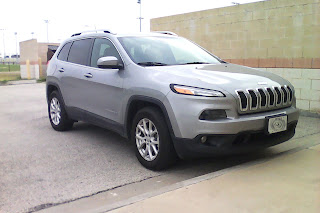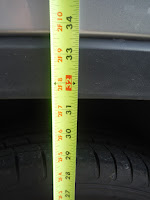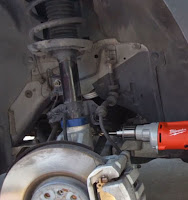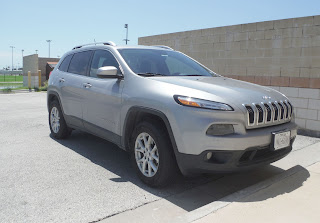Friday, June 23, 2017
Video - Tire Rub Fix for Larger Tires on Lifted 2016 Cherokee Latitude - KL
This video is for those curious about putting 245/70r17 tires on a budget lifted KL Latitude 4x4 with AD1 (Active Drive 1). I installed 245/70r17 All Terrains that are 30.6" when new. I had some slight rubbing on the flexible plastic liner of the rear wheel hub. After implementing this fix, I have experienced no more rubbing. I am not doing heavy offroading as of yet, but will confirm on more challenging trails in the future. My vehicle is mostly for surf fishing and fire road access.
Thursday, June 22, 2017
Video Lifting Jeep Cherokee Latitude 4x4 KL - AD1
This is footage of me doing a budget lift of my 2016 Jeep Cherokee (KL) Latitude 4x4 with Active Drive 1. The lift kit, combined with 30.5" All Terrain tires gave me over 2 inches of increased height. Some people use only spring compressors and some people only disconnect the lower control arm. I did both. I kind of slapped the video together and have some clunky mic moments but hopefully the video helps someone interested in doing this job. I will have another video of making the new tires fit without rubbing.
Monday, June 19, 2017
245/70r17 Tires on Cherokee KL Latitude - AD1 4X4
Upgrading to 245/70r17 tires on a Cherokee KL Latitude - AD1 4x4
Background on selecting these tires
I installed a budget lift on my 2016 KL Latitude in order to upgrade to larger tires. This lift is covered in my previous post here Lifted Cherokee KL Latitude on a Budget - AD1 - 4x4.
The research I did online revealed plenty of examples of 245/65r17 tires, which is a 30" tire, fitting easily and without issue after this lift. What was not so clear in my research, however, was that 245/70r17 tires, a 30.5" tire would fit. There were a lot of posts that said that they "should" fit, or would "probably" fit, but none that I could find of someone actually doing so. I found one example of a guy swapping out the existing trailing arms for Trailhawk trailing arms, which would shift the wheel into the center of the hub and provide enough space to allow for this tire.
The danger area for increasing tire size using the stock trailing arms ends up being the space between the tire and the front of the rear hub.
I was adding an entire inch of tire to my existing setup. The plastic portion of the wheel hub where the likely rubbing would occur, however, had some give to it. Pressing down on it, it appeared that I could get well over 1 1/4" of space here if needed.
Feeling confident, I decided to be bold and order the tires I wanted online. I purchased the 245/70r17 Firestone Destination AT Special Edition with camo pattern sidewalls. The specs on these were 30.6", well that was a tad bigger than 30.5", but I went for it and had them delivered to my house.
The night before I would have these installed at my local tire shop, I started to get this nagging feeling. It occurred to me that I was calculating the difference of one inch on a USED TIRE! These tires had 30K miles of wear on them. My new tires looked enormous when they arrived! I half prepared myself to be embarrassed at the tire shop and possibly sent away.
I prepped the guy at the tire shop as best I could. I informed him that I expected a tight fit, some possible rubbing, and that I even expected that I would be doing some grinding to make them fit. The tire shop was willing to mount, knowing that I knew what the risks were.
I was relieved to see the vehicle brought down from the lift and driven to the parking lot. The gap, however, was almost nonexistent. The "fuzz" of any new tire was actually touching. I experienced some obvious rubbing a few times on the short drive home.
 |
| This is the teency (in addition to weency) gap that I was left with after tires mounted. |
Some corrections would be in order. I was prepared to get the grinding wheel out and go to town, but this would not be necessary.
Here is what I HOPED would work, which did
Rear tires would need to be removed to access the area. This photos shows the areas of mild rubbing.
The area deepest into the wheel well, at the edge of the plastic, I simply removed.
Next I drilled a hole in the plastic where the tire rubs.
Looking deep in the wheel well, we see an existing hole in the trailing arm that can be utilized for a sturdy zip tie.
In this horrendous photo we can see the tightening down of the zip tie, which forces the wheel-well plastic back and away from the tire to the maximum amount, without having to cut and grind further.
After replacing the wheel and lowering the vehicle, I was left with a much more forgiving gap between tire and wheel-well covering.
In testing the vehicle on my normal commute, and even some experiments on curbs, I have experienced no more rubbing with these larger, all terrain tires that I very much wanted to be able to fit on my vehicle. Time will tell if there will be issues during off-road situations. Let it be noted that most of my off-roading is done on the beach. I will have a better opportunity to test the limits of this setup on an upcoming Colorado excursion.
The best part is that, in addition to the budget lift previously discussed, I added an additional inch (approximately) to my ride height.
Final numbers post lift and AT tires:
Front measurement went from stock, no lift height of 30 5/8" to 32 5/8"
Rear measurement went from stock, no lift height of 31.5" to 33 3/8"
There was involved process to get to this point. All quite doable with some spare time and some common tools. The end results are very worth it to me with the new, proud stance of the Jeep and better offroad grip of AT tires. I have much improved clearance and may even be able to do some limited tinkering under the Jeep without jacking it up.
Video now available of this project:
Hey folks. Did you find value in this information? Maybe even $2.50 or $2.99 worth of information? Then consider buying a Kindle, Android or iPhone version of one of my books, which have nothing do do with Jeeps at all. Do give them a positive review if you end up doing so.
Books by Mark Ferdinand are available here:
Amazon Page
iTunes
Google Play
Friday, June 16, 2017
Lifted Cherokee KL Latitude on a Budget - AD1 4x4
KL Cherokee Lift Back Story
Over the years I have owned a few Jeeps. I started off with a Wagoneer Limited XJ, an '88 I believe. Followed that with a 1998 Wrangler Sahara TJ. From there a 1998 Grand Cherokee Limited ZJ which I still have today. A few years ago I purchased a Craigslist 1999 Cherokee Sport XJ with lots of miles and used it as a daily commuter and hobby vehicle. The "hobby" part was taking a lot of time from my weekends, but I loved it. The time finally came, however, to transfer the hobby to another Jeep lover after driving it to 235,000 miles.
 In a moment of insanity, or possibly of clarity, I purchased a lightly used 2016 Jeep Cherokee Latitude 4x4. I was instantly plunged into the future with an unfamiliar design and layout, but I have been liking the vehicle very much. Despite liking it very much, I certainly would waste no time in "Jeeping it up".
In a moment of insanity, or possibly of clarity, I purchased a lightly used 2016 Jeep Cherokee Latitude 4x4. I was instantly plunged into the future with an unfamiliar design and layout, but I have been liking the vehicle very much. Despite liking it very much, I certainly would waste no time in "Jeeping it up".Video available for this project
Lifting
The first order of business - lift it. The lifts available are slight at this time, and may always be, but any lift is a good lift. I bought the Hazard Sky lift - AD1 (Active Drive 1) version, and went straight to work.
Here is the Jeep in raw form with stock suspension and tires:
The lift kit is cheap and great on the budget. I would need a few extra items in order to to get the job done, however, but they were things that any good tool set should have anyway.
The job requires a drill bit, a 12mm drill bit specifically. I read online that people get by with a 7/16" drill bit, which is more common, so that is what I bought. "Getting by" means a bit of hassle in this case. Especially when doing this job under the 90 degree sun. I believe that a 12mm bit would have made life much easier, but it would have had to be ordered or hunted for. I got excited and used the workaround. I also purchased a 19mm socket that I wasn't sure I had, and an additional 18mm socket. I had MacPherson Strut Spring Compressors from a previous lift performed on my XJ. Also, the job requires an E14 socket for the star bolt. This was critical I believe, I didn't want to risk stripping things out or general frustration by using workarounds on the star bolt.
OH! One more thing! If you are lame like me, you may discover that neither one of your drills are capable of accepting a 7/16" or 12mm drill bit. Don't find this out when you are deep into the project. My neighbor saved the day in this regard and loaned me his 1/2" drill.
Initial Measurements
The stock vehicle sat on 225/65r17 tires. This is a 28.5" tire. I measured from the ground in the middle of the tire, up to the rim of the fender. Front measured approximately 30 5/8". Rear measured approximately 31.5". Finally, there is a tight bit of space in the rear wheel hub, well over an inch for most, but this has to be contended with and considered when choosing tires for our AD1 vehicles.
The work
I was a numnuts. I didn't do this job in the winter, spring or fall, I did it in summer in a 9A growing zone with no shade. By the way, whatever the internet home mechanic pros estimate as far as time to complete these jobs, I double or triple that. Never have I had a job that takes "30 minutes", take 30 minutes. You all are simply better than me, or lying. Either scenario is likely.
Speaking only for myself, just about every job like this that I take on has unforeseen challenges and frustrations, be it a stubborn bolt, a trip to the hardware store, or something that simply won't happen as expected. I curse and moan and feel sorry for myself until I figure it out and complete the project, then I return in a couple of weeks to put myself through something else.
I started with the rear, as I suspected this to be the more involved portion. I loosened lug nuts, jacked up the vehicle at our well-designated rear jacking point and lifted. I would need the jack for part of the install, so replaced it with jack-stands.
I utilized a combination of reducing the coil spring tension using MacPherson Strut Spring Compressors with detaching the lower control arm and sway bar link to get the spring out. I felt safer doing it this way rather than solely compressing the springs until they can be removed. It seemed like a nice compromise safety-wise, and I was taking my time anyway.
There are two 3/8" spacers utilized for the AD1 rear lift. These were installed easily and end up looking as they do in this photo:
Putting everything back together required a combination of maneuvering the lower control arm with the jack and aligning the bolt holes to reinstall the control arm and sway bar link bolts. Plenty of frustrating and perplexing moments in between that I am leaving out, but all doable with patience. Most frustrations were brought on by working in the 90-degree heat. Boo friggin' hoo.
The front lift was a tad less involved. Difference here was both front wheels were jacked up at the same time to avoid some twisting that would make bolt hole alignment more difficult. I still experienced some of this, but can only imagine that it would have been worse had I worked with one wheel jacked up at a time.
I removed the front wheels to proceed. Then the bolt supporting the strut was removed using two sockets, the 18mm and the E14.
I also removed the brake line and gave slack to the speed line on the left. This allows the knuckle to be lowered and aligned with an existing hole further down.
With the bolt removed and more slack ensured, I lowered the knuckle easily with a few taps of a wooden block and aligned it with the second, unused hole.
A spacer was provided with my kit to aid in lowering and tapping to the correct distance.
The existing hole had to be drilled out and enlarged in order to accept the NEW bolt and nut. Using the old bolt and nut is not recommended as they are intended for one time use only, to be replaced when removed.
The passenger side took a while as I was being careful with the drilling process. Again, I think the 12mm bit would have made things easier to widen this passage. I then had problems with aligning the hole just right to allow the new bolt to come out the other side. Many curse words were let out until I made it work! With the bolt through, I torqued it down to 90 ft. lbs.
The speed cable and brake line were then secured to their proper positions, allowing slack for movement.
The driver side went much smoother. I guess I had earned that.
Once everything was put back in place and the wheels put back on, the vehicle was lowered. Wow, what a difference! But not so fast, the rear springs would settle, as is normal. I waited at least a day after driving to take final measurements.
Post lift measurements with still stock tires:
Front measurement: Approximately 31.5"
Rear measurement: Approximately 32.25"
The gap between the tire and the front of the rear wheel hub was around the same, but I believe that it actually widened a bit. No photos taken for this.
Now for the post lift photo.
A huge difference? Coming from the world of XJ's and Wranglers and doing 2 and 4 inch lifts, not really. The main benefit will be in allowing an additional inch of lift with larger tires. This makes it all worth it to me. Now it is ready for the installation of 245/70r17 All Terrain tires. These are 30.5" tires.
This would require an additional modification
which will be covered in the next posting!
Hey folks. Did you find value in this information? Maybe even $2.50 or $2.99 worth of information? Then consider buying a Kindle, Android or iPhone version of one of my books, which have nothing do do with Jeeps at all. Do give them a positive review if you end up doing so.
Books by Mark Ferdinand are available here:
Amazon Page
iTunes
Google Play
Labels:
245/70r17,
28.5,
30.5,
AD1,
budget boost,
Cherokee,
KL,
larger,
latitude,
lift,
lifted,
rubbing,
spring compressors,
tires
Location:
Texas, USA
Subscribe to:
Comments (Atom)




























